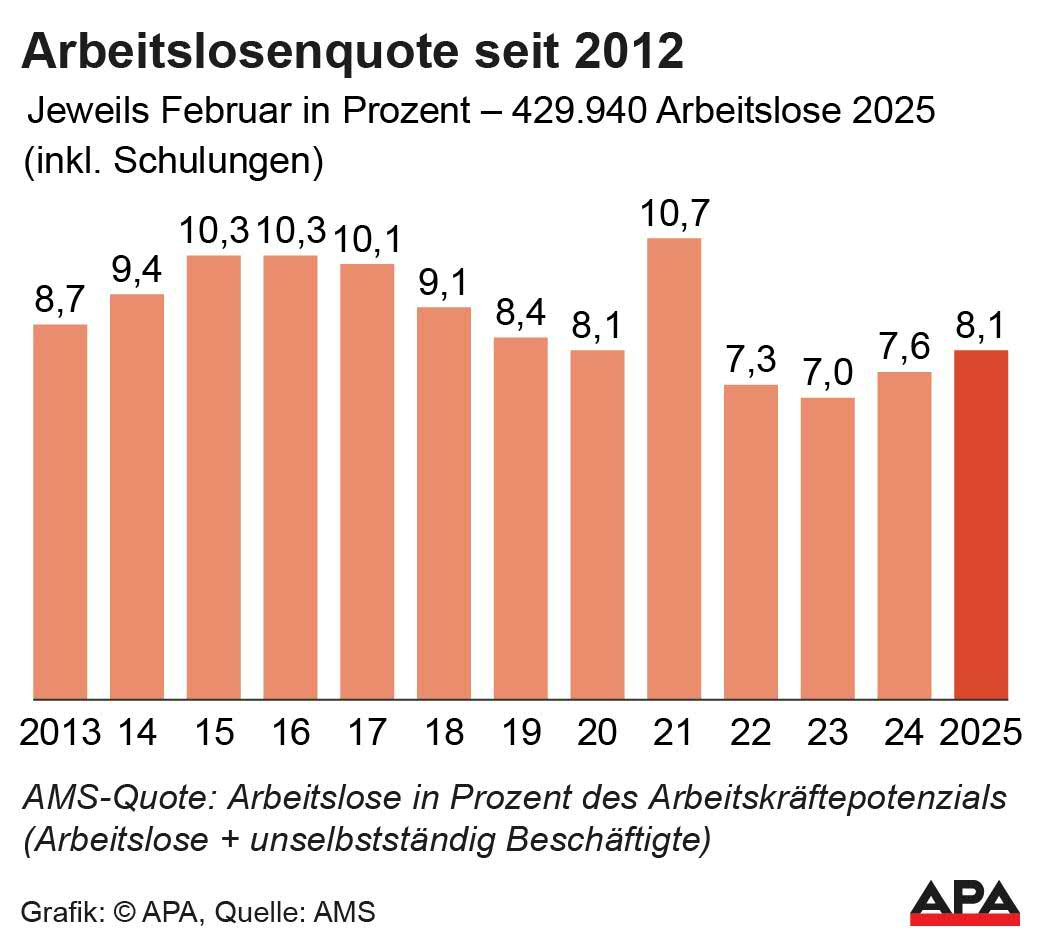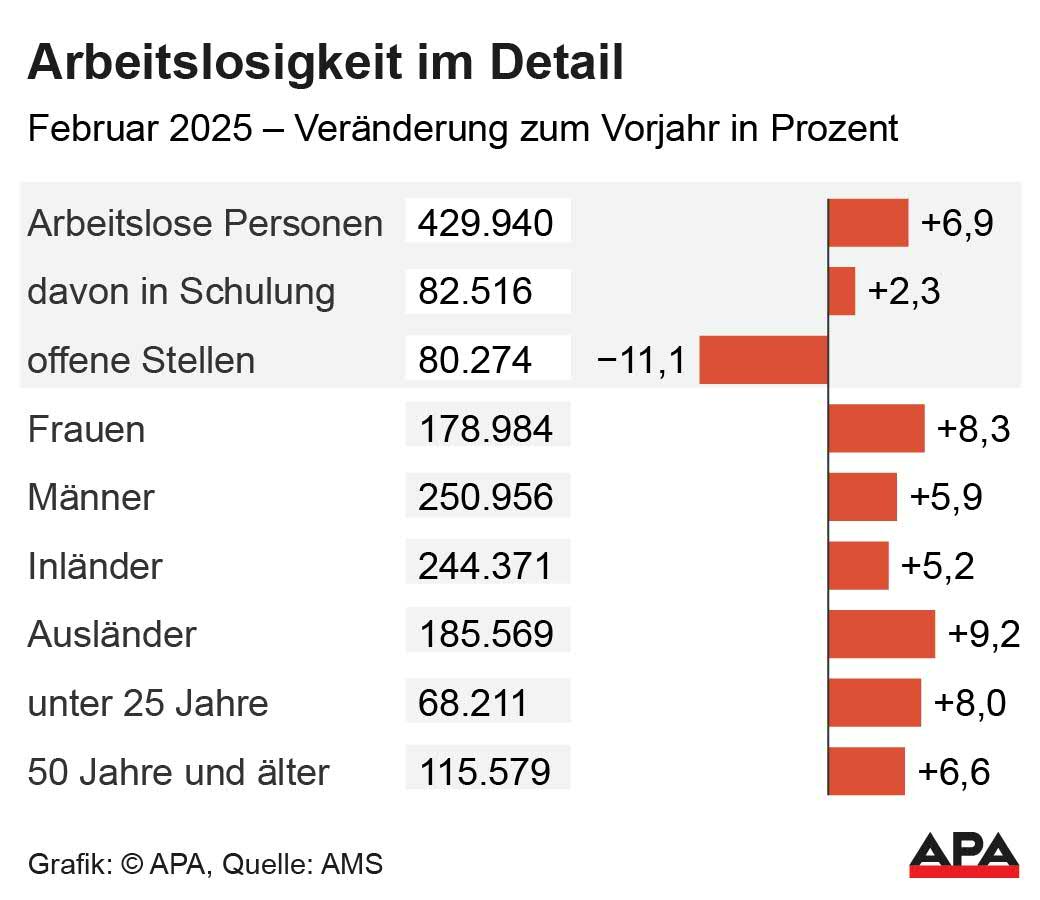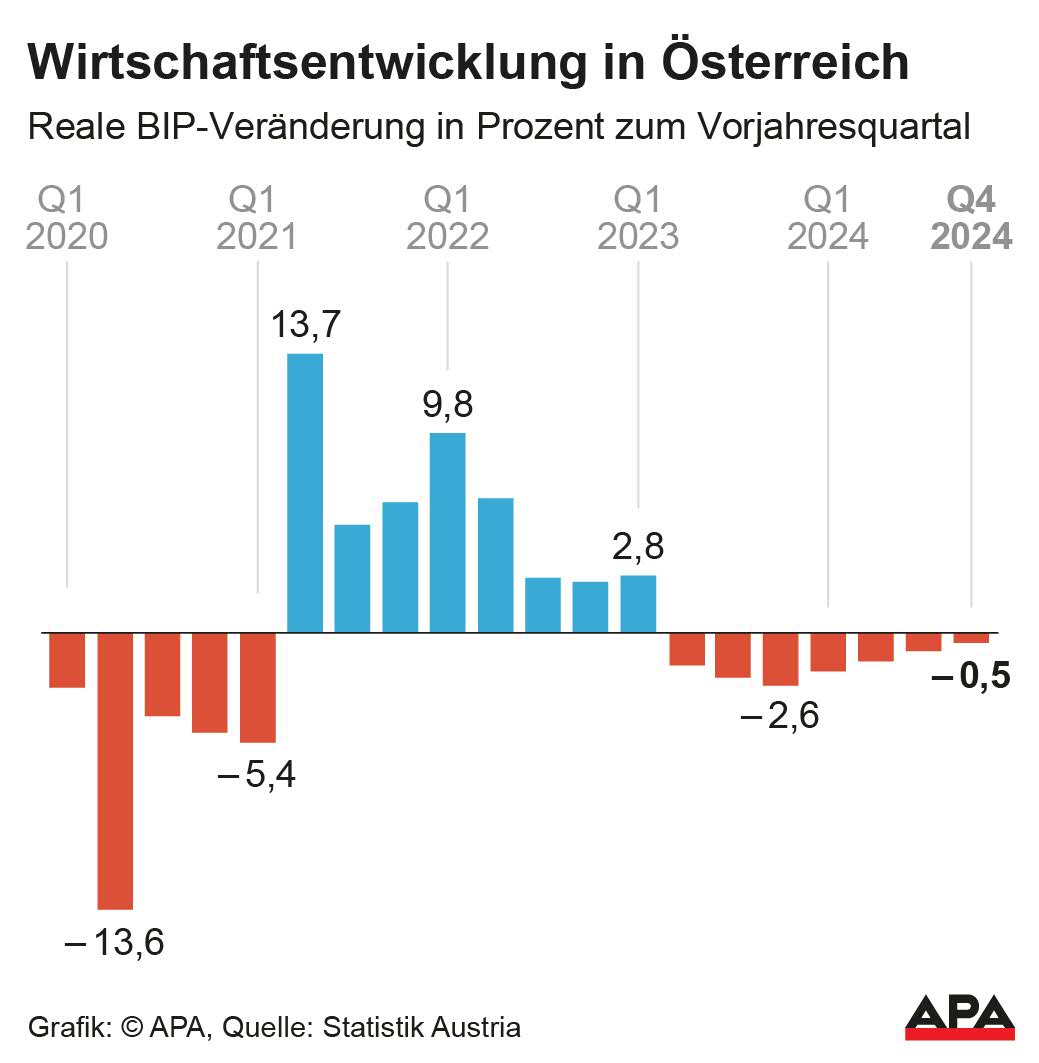```html
Unemployment Increased in February
```

Since spring 2023, unemployment numbers have been rising. The new black-red-pink government will likely have a lot to do economically in the coming months. The weak business development in industry and trade is causing unemployment to continue to rise. At the end of February, 429,940 people were registered as unemployed or in training with the Public Employment Service (AMS).
Higher Unemployment Rate
The unemployment rate increased by 0.5 percentage points to 8.1 percent. "It is not an easy start for a new federal government," commented AMS board member Johannes Kopf on the current unemployment figures in a statement. Austria has been in a recession for about 2.5 years, and this is "clearly reflected in the labor market," he said. Kopf positively assessed the government program of the new turquoise-red-pink coalition. "The new federal government has announced that it will equip the AMS with significantly more budget to combat unemployment. This is an important first step," said the AMS chief.
The three-party coalition does not plan a major reform of the labor market but has provided for numerous individual measures. Additional earnings while receiving unemployment benefits are to be handled much more strictly. A restricted follow-up model for educational leave is planned from 2026. In the previous government, Labor Minister Martin Kocher (ÖVP) failed in his reform of unemployment benefits and educational leave due to resistance from the Greens.
The recession in Austria is significantly burdening the labor market. Unemployment numbers have been rising since April 2023. A noticeable improvement is not yet in sight. The immediately available open positions decreased by 11.1 percent to 80,274 at the end of February compared to the same month last year. The ÖVP Economic Association records all job portals in its job monitor and noted 148,444 open positions. The temporary employment agency Randstad pointed to changing attitudes towards employment in Austria. For the first time in the 22-year history of the Randstad "Workmonitor" study, "job security" (79 percent) has a higher priority for employees than "salary" (75 percent).

The largest percentage increase in unemployed people and those in AMS training at the end of February compared to the same month last year was in manufacturing/industry (+14.9 percent) and health and social services (+12.2 percent). The increase was slightly lower in trade (+8.3 percent), gastronomy and accommodation (+5.7 percent), and transport and warehousing (+5.2 percent). There was a slight increase in unemployment in construction (+2.5 percent) and temporary employment (+0.1 percent).
Upper Austria with the Largest Increase
The highest increase in unemployed and training participants was recorded in Upper Austria (+15.2 percent), followed by Salzburg (+11.2 percent), Tyrol (+8.8 percent), Styria (+7.7 percent), Vorarlberg (+6.3 percent), and Vienna (+5.5 percent). The increase was lower in Lower Austria (+3.6 percent), Carinthia (+3.5 percent), and Burgenland (+2.7 percent). The highest unemployment rate at the end of February was recorded in Vienna at 12.4 percent, followed by Carinthia (9.5 percent), Burgenland (8.4 percent), Styria (7.7 percent), and Lower Austria (7.5 percent). A low unemployment rate was found in Upper Austria (6.4 percent), Vorarlberg (5.7 percent), Salzburg (4.7 percent), and Tyrol (4.4 percent).
The number of unemployed nationals, including training participants, rose by 5.2 percent to around 244,371, and the number of unemployed foreign individuals increased significantly by 9.2 percent to 185,569.

In the Austrian labor market, more and more employees are active, with an estimated 3.935 million at the end of February. However, the total number of actual working hours is decreasing. According to AMS, the reasons for the decline in average working hours per capita are "diverse": The key factors are structural changes in certain industries, the increasing labor force participation of women with a part-time rate of over 50 percent, the reduction of working hours for full-time employees, and fewer overtime hours worked. "In 2008, Austria was still in 3rd place in the EU with an average actual working time of 41.1 hours per week and full-time employee, but by 2023, this figure had dropped to 37.6 hours, placing our country only in 12th place," writes the AMS in a recent special analysis.
"Currently, the trend towards reduced working hours is helping unemployment figures, as companies then need to employ more people," said the AMS chief. "Nevertheless, the fact that we in Austria are achieving less overall with more people in fewer hours is anything but good news," warned Kopf. To finance social systems and maintain Austria's prosperity and competitiveness, "the decline in total working hours must be stopped." The FPÖ also sees a need for action regarding working hours: The hours worked have decreased by 1 percent compared to 2023, "but they need to increase if we want to get out of the recession," said FPÖ economic spokesperson Barbara Kolm in a statement.
To encourage more employees to work full-time again, the new government wants to "rethink" the staggered unemployment insurance contributions. More opportunities should be created for a shift from part-time to full-time work. Specific measures for this are not included in the government program. Overall, the model of marginal employment should be "further developed."
AK President Renate Anderl pointed out in a statement the insolvencies of retailers Kika/Leiner and Palmers, as well as motorcycle manufacturer KTM, and the negative impacts on the labor market. "This negative trend must be stopped. The fight against youth and women's unemployment must now be a top priority," said Anderl. ÖGB Federal Managing Director Helene Schuberth calls for "rapid employment offensives" that were announced in the government program of the new turquoise-red-pink coalition. The ÖVP Economic Association wishes for an "economic comeback": "Tax-free bonuses, favorable overtime, and facilitation for working in old age are essential to stimulate the labor market and counteract the labor shortage," said Economic Association Secretary General Kurt Egger.
Thousands of Apprentices in Training
According to the Ministry of Labor, 97,424 apprentices are currently being trained in Austrian companies, 28,796 of them in their first year of apprenticeship. Currently, there are more people seeking apprenticeships than available positions: 7,891 young people are registered as seeking apprenticeships with the AMS, and the number of open apprenticeship positions amounts to 7,616.

Decrease in GDP
The domestic economic performance also declined in the fourth quarter of 2024. According to calculations by Statistics Austria, the Gross Domestic Product (GDP) fell by 0.4 percent in real terms compared to the previous quarter, with an annual decrease of 0.5 percent. This presents a gloomy picture, as the Economic Research Institute (Wifo) had still expected a decline of 0.2 percent annually in its quick estimate at the end of January.
The location Austria is currently experiencing "the longest period of weakness since the beginning of the corresponding calculations in 1995," explained Statistics Austria Director General Tobias Thomas according to a press release on Monday. Overall, the domestic economic output decreased by 1.2 percent in 2024 compared to the previous year, according to preliminary calculations. "Austria is still in a recession, which has now lasted for two years. By the end of 2024, economic output has declined again, although not as sharply as before," said the head of statistics.

The Wifo, in its quick estimate for the fourth quarter at the end of January, still assumed a GDP decline of 0.2 percent year-on-year and stagnation compared to the previous quarter. For the entire year 2024, the GDP would have shrunk by one percent "based on seasonally and working day adjusted values."
The domestic economy has been struggling with a slump since 2023, but according to Statistics Austria, the decline continuously weakened over the past year 2024. In the first quarter of 2024, the decrease was still about 1.9 percent, in the second quarter it was -1.4 percent, and in the third quarter -0.9 percent.
Manufacturing and Construction Most Affected
The negative development in the fourth quarter affected almost all economic sectors, with manufacturing (-5.6 percent), construction (-2.5 percent), and gastronomy and accommodation (-2.6 percent) being the most affected. However, there were positive growth rates in the area of public administration, health, and education (+3.5 percent). Looking at the entire year, a similar picture emerges, with only trade showing positive impulses in the fourth quarter for the first time (+0.4 percent).
The economic development in the 4th quarter of 2024 was also clouded by the lower investment volume (-2.1 percent) and the decline in exports (-5.0 percent). The declining investments were mainly due to the decreased construction investments (-3.0 percent). Meanwhile, there was a recovery in consumption, which increased by 1.5 percent compared to the previous year's quarter (private consumption +0.8 percent, public consumption +3.1 percent). For the entire year, private consumption remained unchanged, while public consumption increased by 1.6 percent.
Nominal employee compensation recorded an increase of 8.5 percent for the entire year 2024. The number of employees changed only slightly (+0.1 percent), while the number of self-employed decreased slightly (-0.2 percent). The hours worked increased by 2.6 percent in the fourth quarter, resulting in a decrease of 1.0 percent for the entire year.
The Federation of Austrian Industries (IV) is pushing for "rapid" measures to relieve the labor and industrial location. "First positive trends are visible in the economic policy measures announced in the government program, such as bureaucratic relief or measures towards performance incentives," said IV Secretary General Christoph Neumayer. The ÖVP Economic Association is hoping for a "comeback of performance" for the economic location: "Tax-free bonuses, favorable overtime, and facilitation for working in old age are essential to stimulate the labor market and counteract the labor shortage," said Economic Association Secretary General Kurt Egger.
(APA/Red)
This article has been automatically translated, read the original article here.





